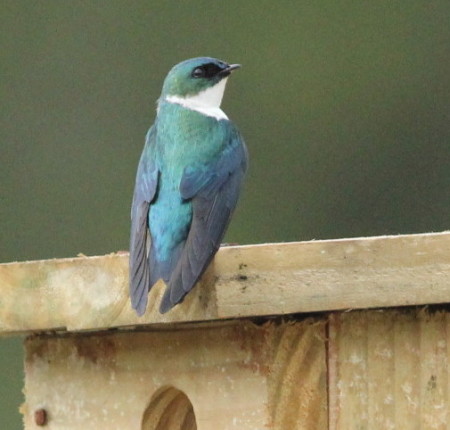
With a title like that, I’m hoping that many of you instinctively hucked your laptops across the room, sprinted out to the barn and started hitching your pride-and-joy appaloosa to the covered wagon your grandpappy gave to you as a belated wedding gift back in the summer of ‘69. Just don’t forget the “caulk the wagon and float” option if you’re coming from the mainland.
If you decide to make the journey, I suggest making landfall on the beautiful island of Hispaniola (gold deposits have all but dried up in Jamaica – but more on that later). Trade in your bikini and flip-flops for some long pants and hiking boots, because what you came for can only be reliably found high up in the mountains. Not that I like to give away too much insider advice, but if I were you, I’d keep heading up until you’ve reached the Hispaniolan pine forests – the highest altitude forest type you’ll find on the island. Find a grassy clearing, sit down, and wait, because at this point, the gold is going to come to you! With mighty wings (~11cm long each), fearsome talons (actually you’d have to strain to even notice the legs on this bird), and a relentless hunger for meat (prey doesn’t get much bigger than an 8mm march fly), watch out as the infamous Golden Swallow comes tearing over the nearest hillside radiating its majestic golden sheen across the lands…wait…wait…I can’t do this anymore. It’s a tiny bird that can’t peck to save its life, and unless the light of a passing-by solar flare manages to reflect off the swallow’s dorsal plumage at a perfect 47.86o angle, the bird is green!
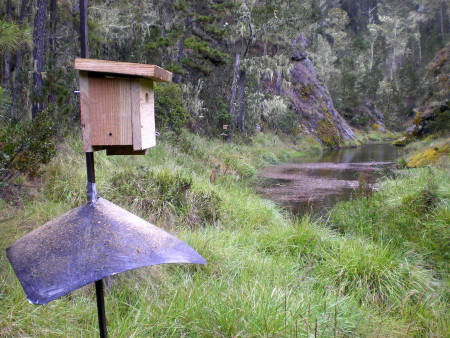
In 2010, in collaboration with the Golondrinas de Las Américas (Swallows of the Americas) project at Cornell University, researcher Jim Goetz and Dominican biologists Esteban Garrido and Jesus Almonthe erected nearly one hundred artificial nest-boxes across a national park known as Parque Valle Nuevo (Parque Nacional Juan Bautista Pérez Rancier) located in the Dominican Republic’s Cordillera Central. Their hope was to attract a sizeable, returning population of breeding Hispaniolan Golden Swallows (Tachycineta euchrysea sclateri) to those nest-boxes so that a formal study of the species could be carried out. By 2012 the plan had worked, and word spread back to Cornell that the time was ripe to find someone to undertake the research. Upon hearing about the opportunity – and conveniently in the very beginning planning stages of my master’s thesis – I decided to give it a go. I was fresh off two years of back-to-back-to-back field seasons working with Tachycineta swallows up and down the Western Hemisphere, and I was ready to find out where else this genus of acrobatic aerial insectivores could take me.
The Hispaniolan Golden Swallow, it turned out, was considered endemic to the island, threatened, and in steady decline. Furthermore, there was so very little known about it. Some work had been done with a very small breeding population that was nesting in crevices within the walls of abandoned bauxite mines located in the Aceitillar region of the Sierra de Bahoruco, but that was really about it. As I came to realize both the extent of what we didn’t know as well as the current plight of the species, I decided that a focused study of the swallow’s breeding biology would simply not be enough. The project would have to be more holistic. The work I decided to do would have to be chosen for its relevance and thus its ability to produce information that helped develop both short and long-term conservation management plans for the species. The project could only truly be successful if its every facet was geared towards having a broader impact on the future of the Golden Swallow. So, I had three years (roughly speaking – this is academia we’re talking about) to make some magic happen, and with the laundry list of ideas and goals growing daily, I knew I was going to need some help. Much to my good fortune, I found smiling faces and willing bodies around absolutely every bend in the road. [All of those people, groups, and foundations deserve their own article – and I plan to write it – but in the meantime let me just say that I’m hoping we all set some kind of record for the 400 word acknowledgment section within our Hispaniolan Golden Swallow monograph that’s currently under review for publication by the JCO.]
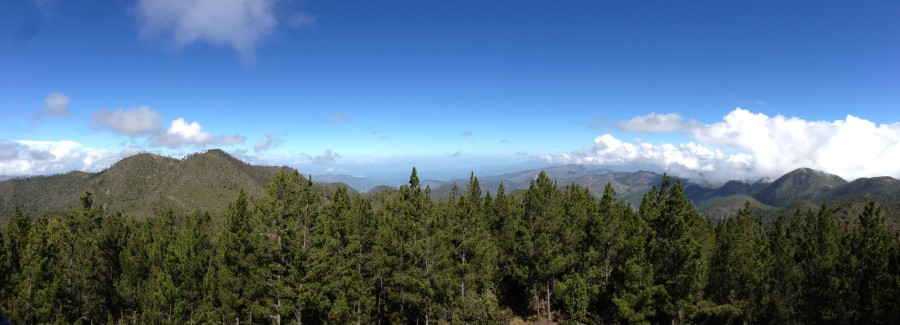
And so we set out on an adventure of a lifetime with the underlying goal of studying a bird and using what we learned to help save that bird, while simultaneously nourishing an already burgeoning sense of local stewardship over Hispaniola’s feathered friends and the habitats they so deeply depend upon. We set the bar high from the beginning, and I can be honest in saying that I feel good about what we accomplished and where the project stands today.
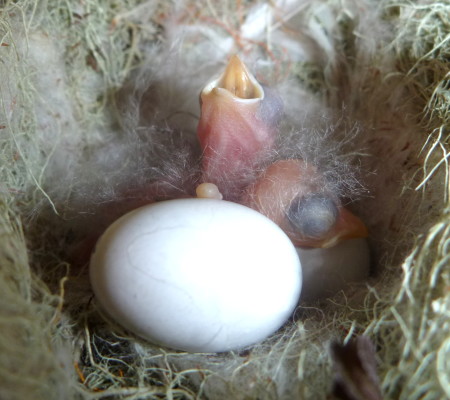
However, as opposed to trying to tackle an impossible play-by-play of what transpired over those next three years (thankfully all of that information is in my master’s thesis and can be yours for just three easy payments of $29.99), I’m going to take a slightly different approach. I’m going to share with descriptions of images (and feelings) that go through my head when somebody kindly asks me, “So how’d that Golden Swallow Project go?” Little does that person know how much weight a question like that can have, or how it causes me to temporary black-out as my mind boards a high-speed emotional (and perhaps somewhat spiritual) roller-coaster from which there is little hope for return for at least the ensuing two minutes. So let’s go for a ride.
- My wife, Marisol, and I are inside of a rental jeep that hasn’t had a tune-up since Elvis left the planet. It’s 10pm (pitch dark), and there is a rather large gathering of people around us. Some are cheering, others look nervous. We are momentarily stopped, looking out in front of us at a raging river flowing out of a stormy valley. The road, of course, stops at one side of the river and continues again on the other side. That “other side” is our only way home, back up into the mountains after having endured a long day of re-provisioning our food supplies down in town. It’s been an intense first field season so far. There have been high highs and some low lows. We really want to get back up to the cabin where we’ve been living, because field work awaits us again at 6am the next morning. Against my better judgment, we begin moving forward and into the river. Despite the water starting to come in through the driver’s side window, the four-wheel drive seems to be working well, and a grin starts creeping onto my face. That grin disappears quickly when all four tires stop making contact with the gravelly bottom of the river and the current begins carrying us downstream.
- I successfully trap and get my first close-up look at a Golden Swallow. It’s a female, and she’s rather calm
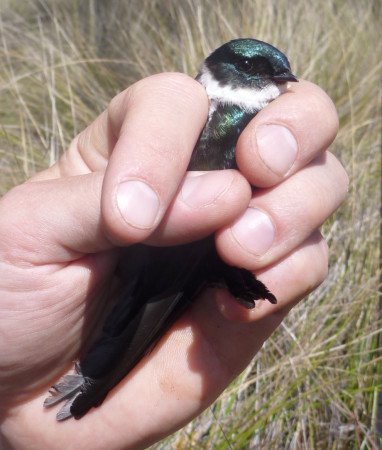
Adult female Golden Swallow in the hand that will soon be measured, banded and then released; Parque Valle Nuevo, Dominican Republic. (photo by Justin Proctor) in the hand. My rule is to keep her no longer than two minutes, during which time I’ll need to take at least four different biometric measurements, describe her plumage, and place an aluminum band on her leg. That doesn’t leave much time to just admire. But a few seconds turns out to be just enough.
- I look at one of our 200 artificial nest-boxes (we expanded considerably our first year) and realize how simple it is. Yet, at the same time, it’s the solution to everything. First, the box provides a nesting cavity for swallows in a habitat where otherwise very few natural cavities exist, which results in more nesting attempts by more pairs of swallows. Second, with the boxes attached to free-standing poles, a predator guard in the form of a metallic cone can be fashioned below the box to thwart attacks from invasive rats and mongoose (not to mention those damn feral cats!). This results in higher rates of brood survival in the face of unnatural – and overwhelming – rates of predation and subsequent nest failure. Third, the boxes are built to be temporarily opened from the side by researchers studying the breeding life history of the swallows. This provides us access to a nearly limitless wealth of data. Fourth, the boxes are tangible, visible, and accessible. These are perhaps the most important features. The box itself becomes a curiosity, a talking point, and ultimately an icon for our collective efforts to protect and care for nature. Although maybe not the long-term answer, the nest-box is invaluable for now.
- My field crew today consists of two Dominicans, one Haitian, two Argentinians, one Cuban, and one Venezuelan. It wasn’t necessarily easy, but we got them all here. Cross-culture-pollination is the bread and butter of great science and conservation work. Amazing how quickly good solutions come in an environment like this.
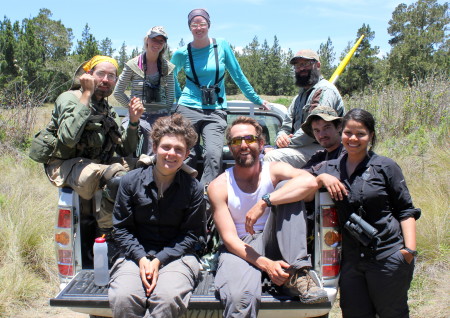
The Hispaniolan Woodpecker field team (led by Josh LaPergola, Cornell University) and the Hispaniolan Golden Swallow field team combine forces; Parque Valle Nuevo, Dominican Republic, 2014. (photo by Marisol Mata) - Josh LaPergola – the legend that studies Hispaniolan Woodpeckers in Jarabacoa – has come to visit me up in Valle Nuevo. He’s brought his entire field crew along with him in an attempt to help me piece together the riddle of why there are so few woodpeckers (and thus cavities that my swallows can use to nest in) in the high-altitude pine forests where I am working. We spent the last two days hard at work, so this evening I’m treating the group to a dip in the upper pool of Aguas Blancas, one of the best waterfalls on the island. Anyhow, Josh does a mean cannonball off the nearby rock face (perfect execution by the way), surfaces a few seconds later, and casually admits that he forgot to take his glasses off before he jumped in. Though the story only goes downhill from there, our admiration for Josh grew stronger that day as we saw in him an inhuman level of determination as he nearly went hypothermic (yes, that water is unforgivingly cold) by repeatedly diving down into the zero-visibility abyss trying desperately to save the fate of his summer. [A big shout-out to Josh, who just unfortunately suffered a serious accident during his 2016 field season, but is currently managing to push through a difficult recovery with nothing but a smile on his face. All our best buddy, we’re thinking of you!].
- My field assistants and I sit down in front of an evening fire with the local park guards in Valle Nuevo. They
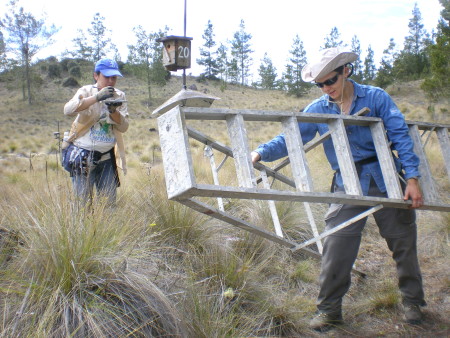
Field assistants Ianela García Lau (Habana, Cuba) and Milagros Jefferies (Mendoza, Argentina) busy checking all 185 nest-boxes for signs of nesting; Parque Valle Nuevo, Dominican Republic, 2014 (photo by Justin Proctor) are bursting with energy, interrupting each other to tell me stories about the Golden Swallows they saw while making their rounds that day. One man says that he’ll give his life for those birds. I laugh, but make sure to grow a little more serious when I tell him that that’s not totally necessary…just in case. At the end of the night, I walk back to the cabin realizing that really well-done outreach takes your passion and makes it contagious.
- I’m sitting at my office in Ithaca, NY in August, post field-season, and receiving a flurry of emails that Parque Valle Nuevo is burning. A forest fire spreads rampantly across the national park, directly through the areas where all of our nest-boxes are located. Everything is lost.
- Not much later, I’m sent a flurry of photos that indicate otherwise. Because the nest-boxes are all mounted on metal posts in meadows away from the forest edge, the fires in those areas have burned low to the ground, passing quickly underneath them. The nest-boxes, in many areas, are the only things left standing. Though a few were lost, word soon comes back to me that they have been replaced. The project carries itself without me – a major success for everyone and a solid indication that many more good things are to come!
As my vision begins to clear, I know all-too-well what I’ll hear next…
“Whoa, sounds like an adventure! So, tell me, what are your plans for a PhD?”
[My vision goes dark again…]
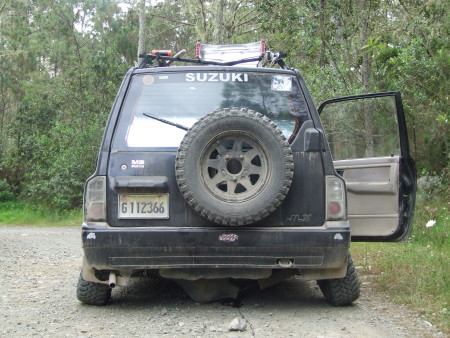
In 2014, I conducted my last full field season in the Dominican Republic (in other words, I had burnt up all of my NSF funding and the winds of change were blowing my wife and me from Ithaca down to Raleigh). That being said, I was (and still am) extremely passionate about Golden Swallows, and more and more so about aerial insectivores throughout the Caribbean (swifts and swallows of course; those flycatchers and nightjars will have to find other sponsors). I did, however, have the pleasure of sneaking in one more (big) Golden Swallow adventure before my master’s defense came around. I was asked by Gary Graves, the Curator of Birds at the Smithsonian National Museum of Natural History, to finish the long-running census work he had been carrying out in Jamaica in search of the critically endangered Jamaican Golden Swallow (T. e. euchrysea) – the only other known race of Golden Swallow and one that hadn’t been reliably seen since the 1980’s. Gary had scoured the island except for two places the Cockpit Country in the northwest and the Blue Mountains in the southeast.
I had never been to Jamaica before, and judging by its miniscule size relative to Hispaniola on a map, I figured I could probably walk across that island in a day. Easy. Well, Proctor men have been wrong before, which means it was bound to happen again. It turns out that remote census work in Jamaica was more physically demanding (by far) than anything else I’d ever done in my life. Luckily, with unwavering field assistants at my side (Seth only collapsed vomiting from the stress twice, mind you, and John only plunged off a cliff once), we hacked our way across as many miles of that terrain as we possibly could in two months’ time. Remember earlier on when I mentioned “gold” being scarce in Jamaica. Unfortunately, that’s the truth. By the end of our work, and in light of compounding evidence in favor, we made a formal declaration that the Jamaican Golden Swallow was indeed extinct (look to Volume 29 of the JCO!). Despite not finding our search target, we were able to document many other interesting behaviors exhibited by the swift and swallow species that still inhabit the island. Furthermore, the extinction of the Jamaican Golden Swallow race brings considerable perspective to the importance of the conservation efforts surrounding the remaining race in Hispaniola.
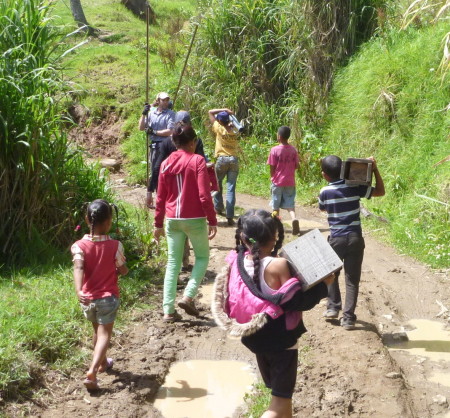
I think that there is a slow, but powerful momentum growing behind the idea of conservation in Hispaniola, and I’m hopeful that the work that so many of us have put into the Golden Swallow Project will continue to help that movement grow. So I encourage all of you to put the mountains of Hispaniola on your bucket list – they won’t disappoint. Maybe there will be a little bit of gold waiting there for you when you arrive.
Your Caribbean Gold Digger,
Justin Proctor
PS. An afterthought – I want to encourage birders and ornithologists (especially those that have somehow made their way through the entirety of this blog post) to pay a little extra attention to aerial insectivores during your future outings, and to document what you see by entering your observations in eBirdCaribbean. We are going to need all the information we can muster in order to grow our information banks strong enough to better diagnose – and do something about – the causes behind the growing, widespread trend of aerial insectivore decline in North America. For many of these species, a little bit of information goes a long way. Thank you!
You can see a compilation video of our work in Jamaica with clips of birds and scenery from sunrise to sunset here.
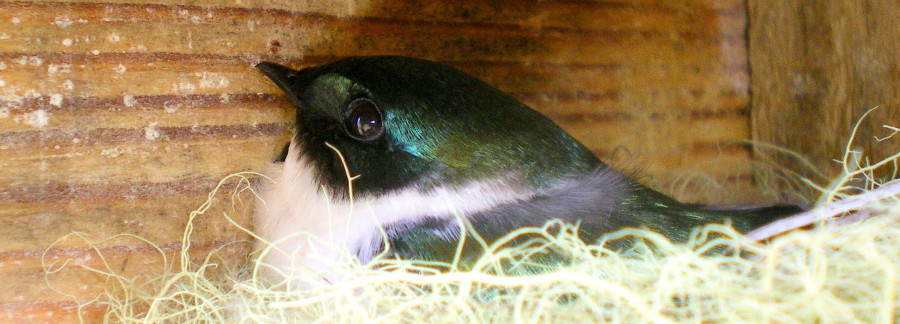

Great Post, Justin. Thanks and good work.
Fantastico!
Justin! que gusto ver tu gran esfuerzo y resultados. Te esperamos, pronto!
Thank you for your positive feedback, we agree with you!